CORNELIUSSULLIVAN.COM
CORNELIUS EDMUND SULLIVAN
Virgin of Pieta, detail, Carrara Marble, life size. 2006-2025.
Art- https://www.instagram.com/corneliussullivan90/
Writing Lectures and Articles- https://avemaria.academia.edu/CorneliusSullivan
Writing on this Website- https://corneliussullivan.com/writing-html/

Pieta and Sculptor's Daughter Rachel
CARVING A MARBLE FACE 151,444 https://www.youtube.com/watch?v=5VwpuuaJS4g&t=121s .
INTRODUCTION TO CARVING MARBLE, video by Brendan Weston https://www.youtube.com/watch?v=yr1X0ABg2dU&t=5s


My drawing of the marble of Saint Cecilia in the Altar at her Basilica in Trastevere, Rome.
From Caravaggio : A Life by Helen Langdon



Sacred Art and Modernism, Form Separated from Content

Angel of the Mountain, Carrara marble, 2011, Private Collection Kennebunkport, ME.
BIOGRAPHY
Cornelius Edmund Sullivan MFA has taught Drawing at the Harvard University Graduate School of Design, and Drawing and Sculpture at The University of Miami, Painting at The University of Miami School of Architecture, Drawing and Etching at the Danforth Museum, and Art History at Florida International University. He studied Physics at Boston College and completed a Bachelor of Fine Arts from Rhode Island School of Design in 1991 and a Master of Fine Arts from The University of Miami in 1996.
For many years he was an Artist in Residence for the City of Cambridge, MA School Department. At the same time he served as the elected Artist's Representative to The Board of Directors of The Boston Center for the Arts and was a Master Etching Printer at Impressions Workshop Atelier in Boston. His works are in many private collections, churches, and in universities and museums.
He has been a lecturer and consultant in Rome beginning in 2007 for ContextRome.com leading the "Caravaggio Seminar", and tours of the Vatican Museum and Saint Peter's Basilica, and "Galleria Borghese". He is a journalist and art critic for The Italian Insider Newspaper and Inside the Vatican Magazine based in Rome and for The Saint Austin Review Magazine, South Bend, Indiana.
Mr. Sullivan was invited in September to attend a Conference for Foreign Journalists at the Vatican hosted by Sant Croce Pontifical University and was issued a Journalist's Vatican Press Pass for the Conclave of 2013.
He was a Visiting Lecturer at Ave Maria University, Ave Maria Florida, on Renaissance Art, and co -taught a class on Theology and Art with Theologian Michael Waldstein, Max Seckler Professor of Theology.
contact CorneliusSullivan1@gmail.com

Notes from Rome The articles were published in The Italian Insider Newspaper based in Rome and The Saint Austin Review in South Bend, Indiana.
WRITING
CARAVAGGIO Rome's extravagant celebration of Caravaggio- How can we know another man's death. The Italian Insider Newspaper
published July 11, 2011
Caravaggio, Saints and Sinners- Caravaggio painted sinners as saints. August 13, 2011.
Caravaggio on the Run in Malta March 26, 2012 "Masterpiece"- J. P.
Caravaggio, the Interview- My art, it is oil paint on canvas, and I put it on with these hands. August 25, 2012
My Interview with Saint Peter, the Art of Martyrdom November 3, 2012
Attacks on Caravaggio I saw him there in the street, the narrow street, Via del Leone, June 4, 2012
Caravaggio Reveals Himself- The most unlikely candidate August 3
Caravaggio and the Marilyn Elvis Syndrome- Only the good die young. July 25
Caravaggio and the Aesthetics of Meaning- Caravaggio is the antidote to Conceptual Art. September 27,
Caravaggio, Rembrandt, and Vermeer, not just realists- Caravaggio used light to tell the story. September 6
Caravaggio Speaks to the Modern Age June 20, 2012
Who is Saint Matthew for Caravaggio August 7, 2012
Another Bogus Caravaggio Discovery July 10, 2012
Tranquillo Caravaggio, the Town June 26, 2012
Caravaggio Borrows from Michelangelo December 18, 2011
MICHELANGELO
Looking Over Michelangelo's Shoulder as He Carves Marble Gloucester Lecture One- The Italian Insider- http://www.italianinsider.it/?q=node/4680
Michelangelo in Rome November 15, 2011
Carving Marble by the Michelangelo Quarry in Carrara Summer 2014
A Lost Michelangelo, don't get your hopes up July 18, 2012
SACRED ART
Sacred Art and the Theology of the Body, Caravaggio, http://www.italianinsider.it/?q=node/2843
Sacred Art and The Theology of the Body, Part One, Caravaggio related- Exhibition at Ave Maria University, 2015,
ART CRITICISM
The first article published by The Italian Insider Newspaper-
Papa Wojtyla as Capeman June 30, 2011 "Erudite"-J. P.
Capeman II: Papal Statue not Improved November, 20, 2012 "Well said".- M.P., "Great Article"-C.S., P.A.
Rev. Martin Luther King Jr. as Mao February 2012
Art Mysteries Solved, a Leonardo, a Michelangelo, and a Raphael October 11
Moor Fountain in Piazza Navona vandalized September 6
My Art of the Blessed Virgin feature article , Fenestrae Coeli, Saint Austin Review, January/February 2012
March 12
Benedict, Monks, Mystics, and Hermits written March 2, 2013
Cardinal Joseph Ratzinger, Theologian in Residence February 26
The Pope out Back and the Conclave February 14, 2013
Does God Have a Face http://www.italianinsider.it/?q=node/3201 February 13, 2013 "Thoughtful and stimulating as ever"- JP
Lectures: These three lectures are related, variations on the same theme delivered at different times.
Sacred Art and The Theology of the Body
OTHER
American Views of the Amanda Knox Verdict November 3
The Roman Forum June 8, 2012
Too Hot in Rome " I really like this." -N. G., "That's Him"- T. A. and others
Essays
March 23, 2016 I wrote this short piece yesterday for John and Ashley in Rome who produce Voice of the Vatican,
for a TV video they are shooting today. Crucifixion with Saints, Pietro Perugino
all content copyright Cornelius Edmund Sullivan 2025
ARTWORKS SOLD, Public and Private Collections
Pieta, Carrara Marble, life size, 2006-2017, 2025. Carving Blog from day one.home
SCULPTURE WITH DIMENSIONS


Pieta, Life Size, Carrara Statuario Marble, 20" High, 28" Wide, 7" Deep.
CRATE

Pieta, marble. 23" High, 13" Wide, 8" Deep.
CRATE

Mary, Marble, life size. 19.0 High, 11" Wide, 11" Deep.
CRATE

Saint Philomena, 70" High, 36" Wide, 18" Deep.= 26 cubic feet x 170 lbs per cubic foot = 2.21 tons
CRATE

Madonna and Child, marble, life size, 16" High, 24" Wide, 10" Deep.
CRATE

Emerging Figure, marble. 14" High, 17" Wide, 12" Deep.
CRATE

Rachel, just smaller than life size, Vermont Imperial Danby Marble with oil paint.
12" High, 8" Wide, 7" Deep.
CRATE
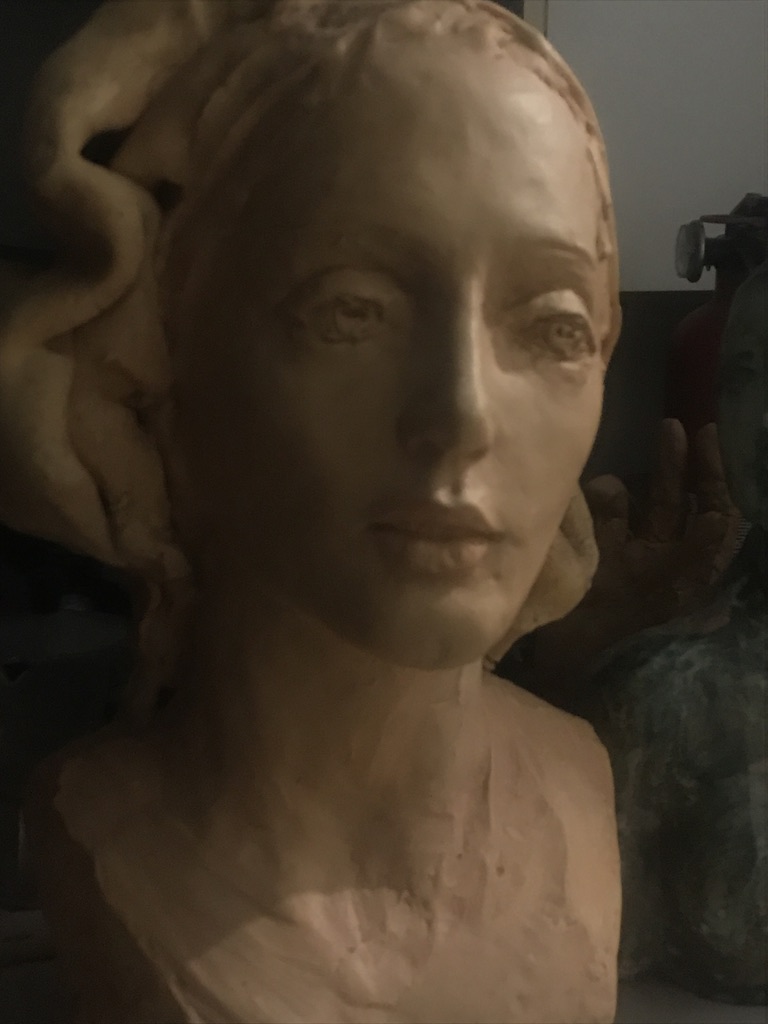
Desiree, terra cotta, Life size. 17" High, 10" Wide, 9" Deep.
CRATE

Angel Paros Marble, life size, 17" High, 14" Wide, 7" Deep.

Christian, Bronze relief set in marble. 17" High, 18" Wide, 2.5 " Deep.
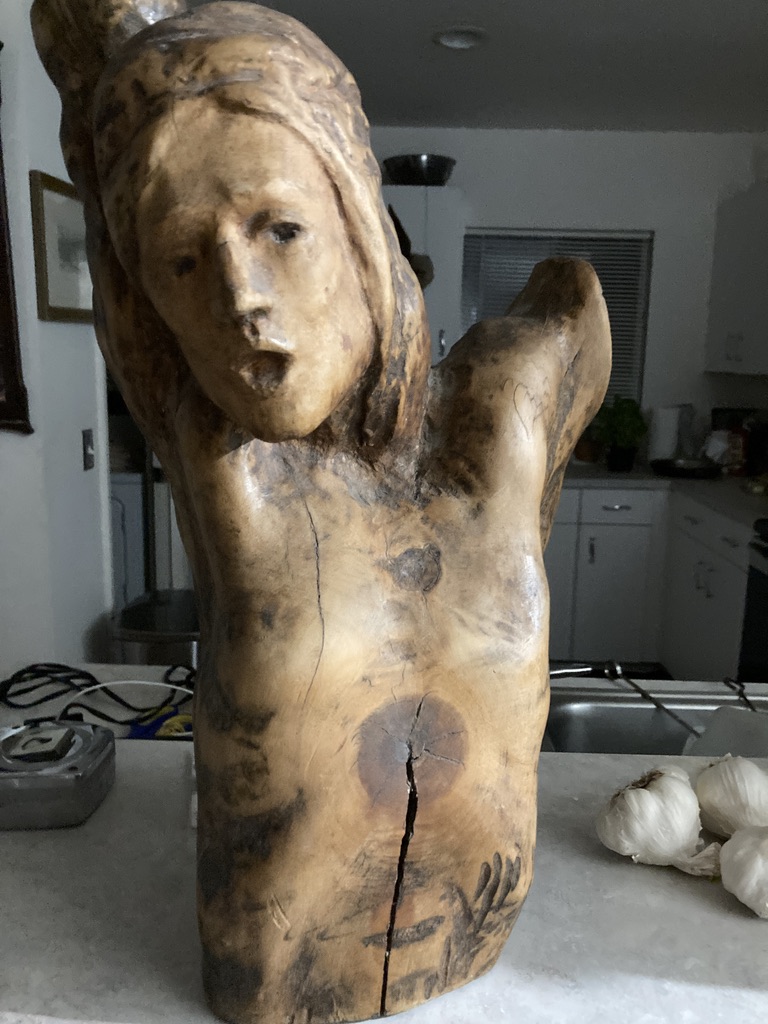
Crucifix, detail, box wood, 20" High, 11" Wide, 7" Deep.
.

Bust, Glazed terra cotta, University of Miami student. 13" High, 9" Wide, 6" Deep.

Veronica's Veil, marble.

Profile, Marble.

Kathleen, detail, relief, Vermont Statuario Marble. 12" High, 12" Wide, 1" Deep.
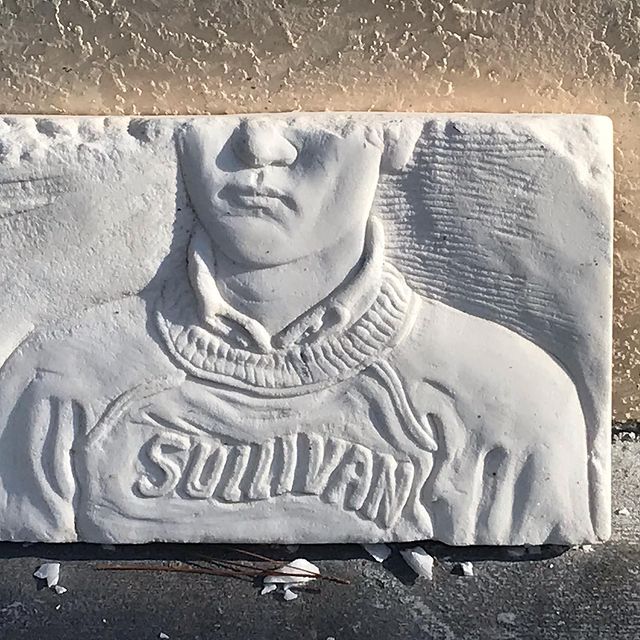
Sullivan Sweart Shirt, Vermont Marble. 12" High, 18" Wide, 2" Deep.

Goliath Bird Bath, Italian Roman Tavertine Marble

Kathleen, plaster, Life size.
ART STORIES FOR MY GRANDCHILDREN
EXHIBITION AT AVE MARIA UNIVERSITY April 15 to May13, 2015
From a review of an Exhibition at Ave Maria University-
· “Mr. Cornelius Edmund Sullivan earned his B.F.A. from Rhode Island School of Design in 1991, and completed his M.F.A. from the University of Miami in 1996. He has taught and lectured around the world, including at Harvard University’s Graduate School of Design, the University of Miami School of Architecture, the Danforth Museum, Florida International University, and frequently in Rome.
Most recently, Sullivan co-taught a course at Ave Maria University with Dr. Michael Waldstein, “The Theology of the Body in Renaissance Art: Michelangelo, Titian, and Caravaggio” (THEO 595), which sought to “stimulate awareness of the non-verbal theology of the great Renaissance artists” (cited from the course description).”- May 5, 2015.
essay by the artist on the Exhibition
The exhibition and an article are both related to a class being taught by Cornelius Sullivan and Theologian Michael Waldstein, The Theology of the Body and Renaissance Art.
The article on this website- Sacred Art and The Theology of the Body, Part One, Caravaggio
and published in Rome last week- http://www.italianinsider.it/?q=node/2843
INTRODUCTION TO CARVING MARBLE, video by Brendan Weston https://www.youtube.com/watch?v=yr1X0ABg2dU&t=5s
Madonna and Child, Conyers Georgia, carved in Pietrasanta, Italy.Cornelius Sullivan© 2021 Video Part One CARVING A MADONNA AND CHILD, PIETRASANTA, ITALY, 20,152 views https://www.youtube.com/watch?v=_9FMsbaSE-A&t=35s CARVING A MADONNA AND CHILD, CONYERS, GA. Part 2 https://www.youtube.com/watch?v=PE-VhvptzLo
Without beauty we cannot love. Hans Urs von Balthasar TUESDAY, JULY 18, 2023
Beauty is the word which shall be our first. Beauty is the last thing which the thinking intellect dares to approach since only it dances as an uncontained splendor around the double constellation of the true and the good and their inseparable relation to one another. Beauty is the disinterested one, without which the ancient world refused to understand itself, a word which both imperceptibly and unmistakably has bid farewell to our new world, a world of interests, leaving it to its own avarice and sadness. No longer loved or fostered by religion, beauty is lifted from its face as a mask, and its absence exposes features on that face which threaten to become incomprehensible to man. We no longer dare to believe in beauty, and we make of it a mere appearance in order the more easily to dispose of it. Our situation today shows that beauty demands for itself at least as much courage and decision as do truth and goodness, and she will not allow herself to be separated and banned from her two sisters without taking them along with herself in an act of mysterious vengeance. We can be sure that whoever sneers at her name as if she were the ornament of a bourgeois past – whether he admits it or not – can no longer pray and soon will no longer be able to love. – from “Seeing the Form” in The Glory of the Lord
all content copyright Cornelius Edmund Sullivan 2024
Two Minute Carving Video
Christmas 2021
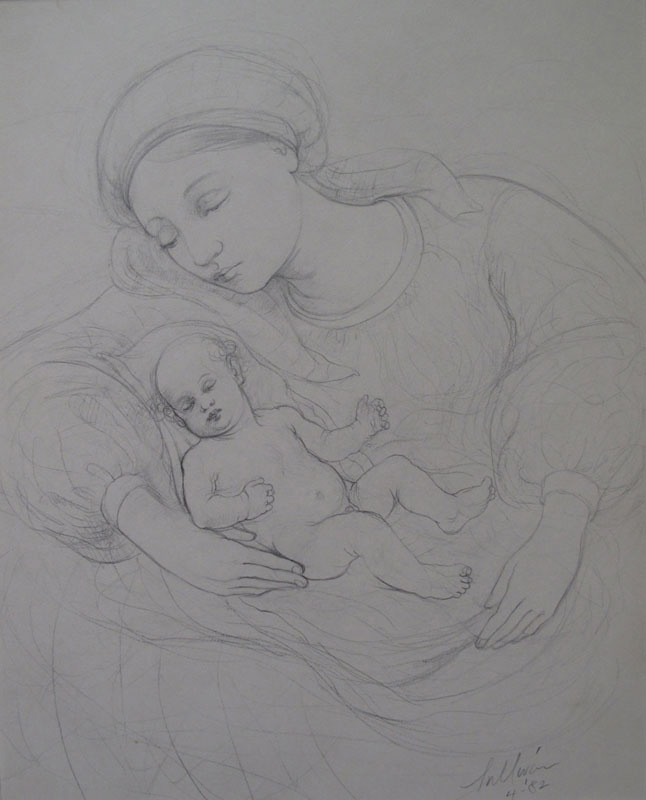
Madonna and Child, pencil, 11 x 14".

Madonna and Child, Carrara Marble, life size.
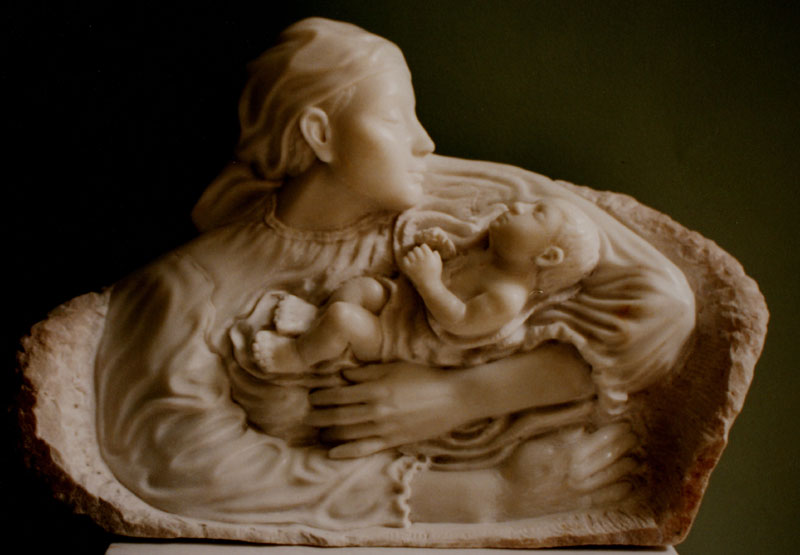
Madonna and Child, marble, life size, Our Lady of the Holy Rosary Church, Miami, FL.
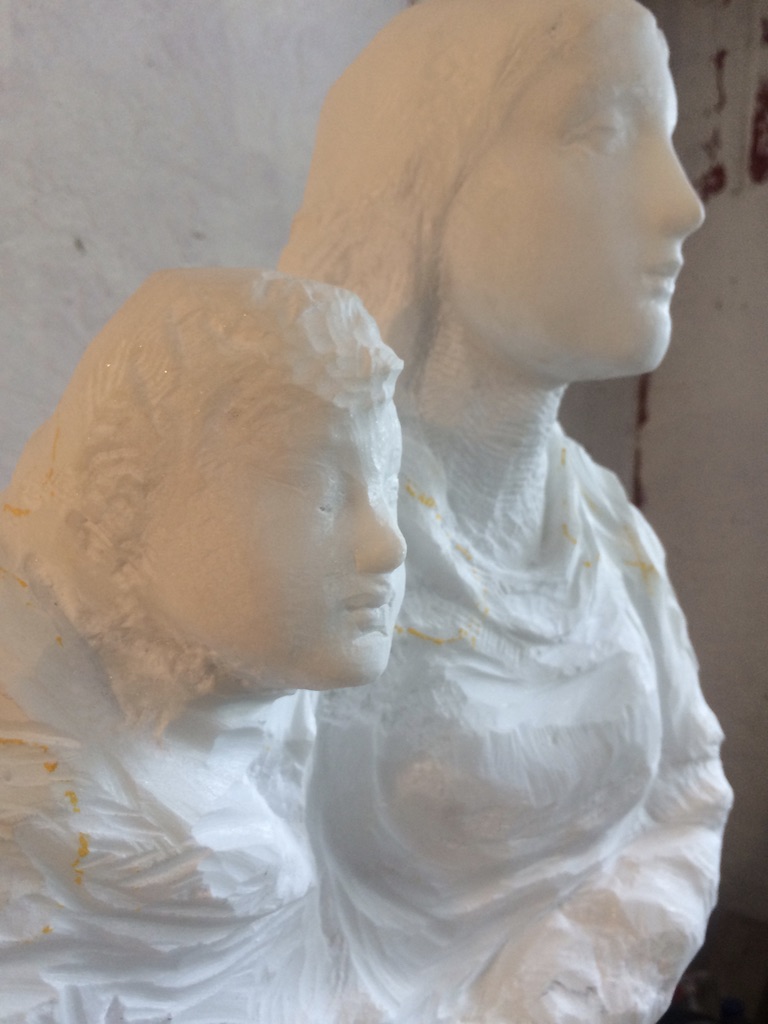
M&C Carrara Marble, 4 feet high detail, unfinished.

Madonna and Child, etching, collection of the artist.

M&C Pencil, watercolor, and gouache.
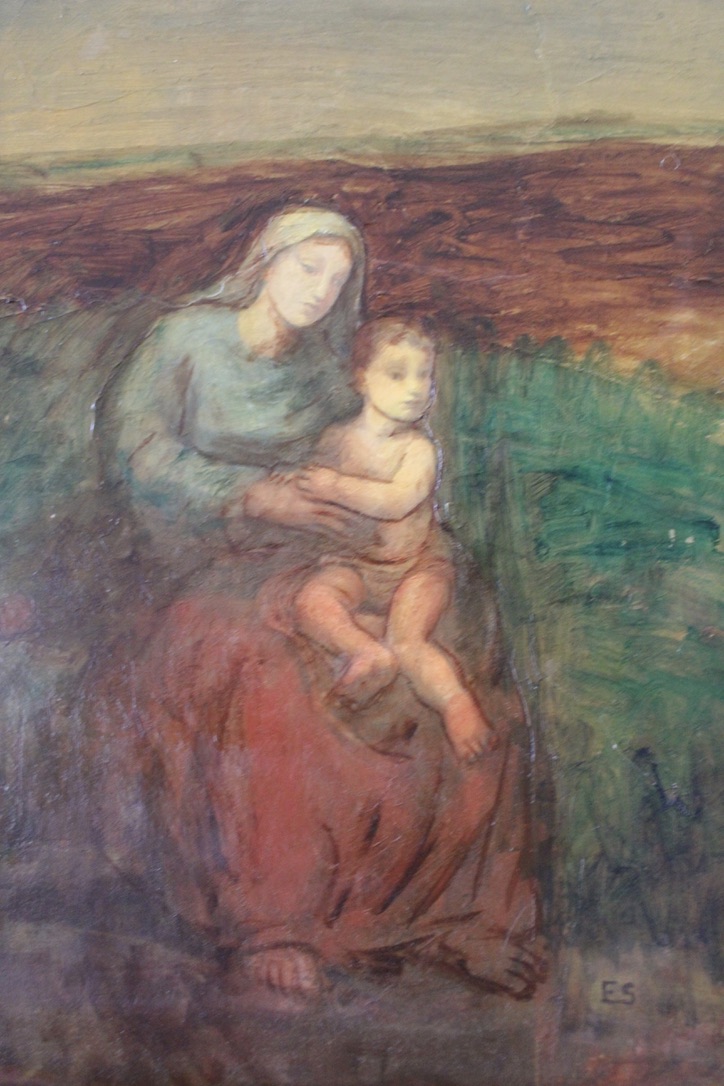
M&C oil on canvas.

Our Lady of Good Voyage, etching with watercolor and gouache, edition of 15.
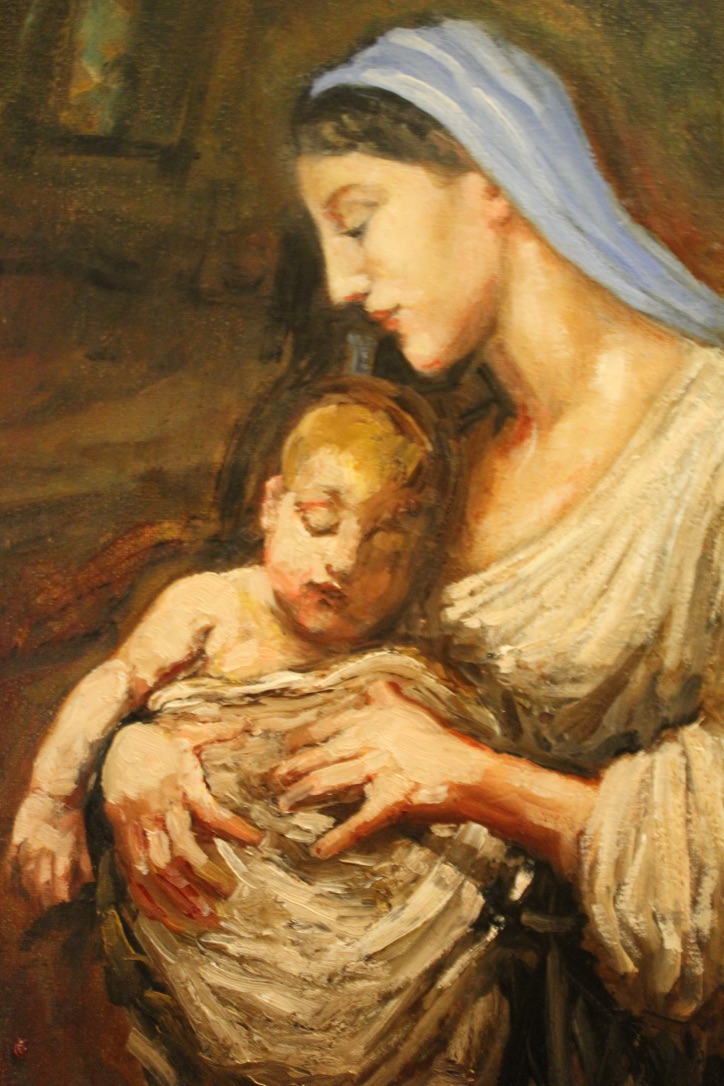
M&C, oil on canvas.
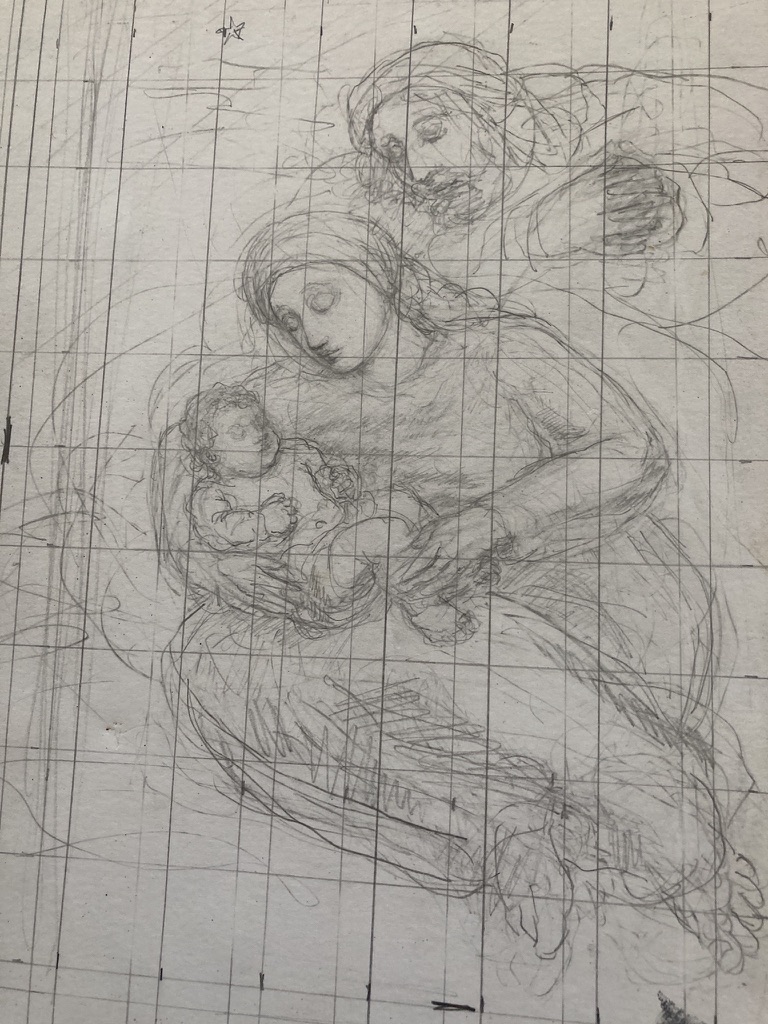
Holy Family, pencil.

The Newborn Child, after De la Tour, pencil and watercolor.
SACRED ART
Cornelius Sullivan
I made some paintings with the idea that you were there in the crowd, a witness, that these events were in Revelation, part of human history.
.
Descent from the Cross, oil, 16″ x 20″

Loaves and Fishes, oil, 5 x 8
‘.
Vision of Saint Michael the Archangel, oil, 3 x 5′, 2011.

In Rome Emperor Hadrian’s Tomb had its name changed since a vision of Saint Michael the Archangel appeared in the sky above the mausoleum. He was sheathing his sword to signify that the Plague of 590 AD would end. The bui;lding is now called Castel Sant’Angelo.
The painting is my representation of the vision seen by Pope Gregory the Great and hundreds of pilgrims as they processed from the Basilica of Saint Mary Major through the streets of Rome toward Saint Peter’s Basilica carrying an icon of the Virgin Mary, Holy Mary, Protectress of the Roman People, Santa Maria Solus Populi Romani, believed to have been painted by Saint Luke. Saint Michael dressed in the armor of a Roman soldier, is returning his bloodied sword to the scabbard, signifying that the plague of 590 AD would end. Emperor Hadrian’s Tomb has since been called Castel Sant’Angelo.
The miraculous vision of the archangel was commemorated by a chapel dedicated to St. Michael built atop the mausoleum and later by a statue of the angel placed atop the chapel. Pope Gregory’s vision was never forgotten. It was confirmed by a similar miracle marking the end of the Black Death of 1348.”
Information is from a history of some apparitions of Saint Michael the Archangel at Castel Sant’Angelo from The History and Decoration of Pont S Angelo, Mark Weil, 1974, The Pennsylvania State University Press:
- H. Dudden, Gregory the Great,London, 1905.

Angel of Plenty, 46″ x 38″, 2008.
Abortion

Abortion, oil on canvas, I had thought that a reason a woman might have an abortion is because the act is hidden. In the painting the mother is turning away and the horse is blindfolded.
About Abortion Pope Benedict has said “We must use our eyes.”
“In addition to the legal problem, on a more fundamental level we have the moral problem that passes through the heart
of each one of us, in that hidden interior room where our freedom decides good and evil. I have said that, when the decision is taken in favor of abortion, there is necessarily a moment at which one agrees to shut one’s eyes to the right to life of the little one who has just been conceived. The moral drama, the decision for good or evil, begins with our eyes, when we choose whether or not to look at the face of the other. Why is infanticide almost unanimously rejected today, whereas we have become virtually inured to abortion? Perhaps the only reason is that in the case of abortion, one does not see the face of the one condemned to never see the light of day.”

Madonna and Child, marble, life size, Our Lady of the Holy Rosary Church, Miami, FL.

Madonna and Child, Carrara Marble, 11 feet high, Conyers Georgia, 1998,
carved in Pietrasanta, Italy. This is a pro life image because the child is in a fetal position.

Our Lady Shelter From The Storm, marble, life size, collection of Our Lady of the Holy Rosary Church, Miami, FL.

Madonna and Child,pencil, 1982, 11″ x 14″, collection of the Artist.

Christmas Painting, oil, 40″ x 40″, private collection Cuba, New York.

Madonna and Child with Lilies terra cotta, life size.

Gethsemane, oil, 16×20″, 2001

Crucifix,wood, wood, 24″ high.
.

Pieta, marble, 1981.
This work was stolen from a moving van on October 3rd, 1993, in Weymouth, Massachusetts.” Reward , Contact the FBI or Weymouth Police.” Ten years later: Pieta Recovered August 7, 2003. Boston Globe, NAMES by Carol Beggy, August 12, 2003.
T

Hanging Crucifix, wood, nine feet by nine feet., collection of Our Lady of the Holy Rosary Church, Miami, FL
In his homily at Our Lady of the Holy Rosary Church on September 9th, 2001, Archbishop John C. Favalora said of this corpus, ” His body has become the cross.”

Altar and Crucifix,wooden crucifix, 9′ x 9′, altar is terra cotta panels set into a three ton block of Florida’s indigenous coral rock, 1996, Our Lady of the Holy Rosary Church, Miami, Florida.



Dome of Saint Peter’s Basilica, pencil, 12″ x 17″. Back in 1979 there was a cafe on the roof where you could sit and draw

Double Image, Turin Shroud Head and Crucifixion, ink and wash.
Article published in The Italian Insider Newspaper, Rome. Does God Have a Face? http://www.italianinsider.it/?q=node/3201

Drawing Saint Cecilia
Drawing the Stephano Maderno marble sculpture of Saint Cecilia, Basilica of Saint Cecilia, Rome, 2011.
From Caravaggio, A Life by Helen Langdon, p-162


Santa Cecilia, conte and pencil, 2011, collection of the artist.

Drawing of Blessed Ludavica Albertoni after the marble by Bernnini, San Francisco a Ripa Church, Rome

Lamentation, oil, 36×48″.

Lamentation, oil, 36 x 48″, 2012, collection of the artist.

Saint Jerome, terra cotta study for marble, 19″ high.
Proposal for a large marble for Sant Jeromes Church, Fort Lauderdale, FL.

The Good Shepard, terra cotta study for marble, 22″ high.
Proposal for a large marble for Good Shepard Church, Kendall, FL.

Head of Christ, pencil.

Bronze Angel. I learned that Ancient Greeks used marble molds carved in reverse for casting bronze.
This was done as an Artist in Residence at the Rhode Island School of Design Foundry.

EXHIBIT: THE SACRED ART OF CORNELIUS SULLIVAN
Mr. Cornelius Edmund Sullivan earned his B.F.A. from Rhode Island School of Design in 1991, and completed his M.F.A. from the University of Miami in 1996. He has taught and lectured around the world, including at Harvard University’s Graduate School of Design, the University of Miami School of Architecture, the Danforth Museum, Florida International University, and frequently in Rome.

Blessed is the Fruit of Thy womb, oil on canvas, 30×40″.
Most recently, Sullivan co-taught a course at Ave Maria University with Dr. Michael Waldstein, “The Theology of the Body in Renaissance Art: Michelangelo, Titian, and Caravaggio” (THEO 595), which sought to “stimulate awareness of the non-verbal theology of the great Renaissance artists” (cited from the course description). Jesus came to earth in the flesh, Sullivan pointed out. He did not arrive “with a list of moral principles” but with an offer of love. One of the arguments of the Theology of the Body is that concupiscence is due to a loss of vision stemming from a lack of love; man has forgotten how to see himself, and others, in relation to God. The answer to concupiscence is not in the memorization of moral principles, but in the restoration of man’s proper vision.
Appropriately then, the course co-taught by Sullivan and Waldstein aimed at helping the students see the art they studied. The professors told the students: “Just look. Learn how to look.” By slowly stripping away the characters and ancillary elements, Sullivan explained, the class would arrive at the “essence of the painting.” He recounted the story of how, during one class, they spent three hours stripping away the elements of Caravaggio’s painting “The Calling of Saint Matthew” until only the figures of Matthew and Christ remained. As the class continued to look, Waldstein exclaimed: “It’s love at first sight.” They had arrived at the essence of the painting and a deeper understanding of Christ’s call.
Of the twenty-four works on display in the Canizaro library, perhaps Sullivan’s “Loaves and Fishes” (c. 1984) stands out the most—not just because of its large size. The figure of Jesus, his face obscured in shadows, his back and miracle-working hand bathed in light, reaches over a table filled with colorful fish exploding outwards toward the viewer. Various characters, crowded and yet isolated, are seen coming and going. “I want it to be like you’re there, you’re in the crowd, while this cosmic event is taking place,” Sullivan commented. He achieves a similar effect in his “Descent from the Cross,” and more mysteriously so in his “The Annunciation” (neither of which is currently on display).
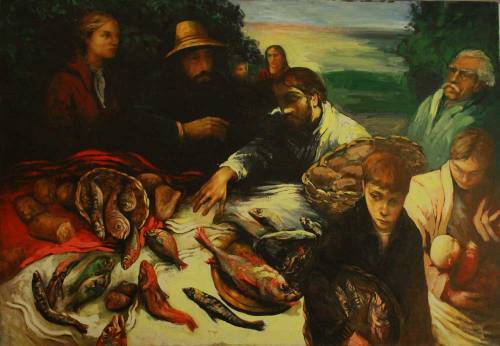
“Loaves and Fishes,” oil, 5 x 8′, c. 1984.
Sullivan is a figurative artist—his works are representations of the real, most often of the human figure. Yet he considers himself a modern artist, balancing figure and form, representation and medium. “I want the object itself to have a presence,” he said, “so I push it until it does.” In his work, there is a clear sense of the medium, be it the thick drips of paint on the canvas, or the rough edges of the marble reminding the viewer of the stone’s original form. But these elements, he insisted, are not a break from his teachers or guides—artists like Michelangelo and Caravaggio. “Renaissance artists were modern artists,” Sullivan said. The rough cheeks of Sullivan’s sculpture “Cararra Madonna and Child” (2014) and the face trapped in, or emerging from, the marble of his “Angel” (2012) are not so far removed from some of Michelangelo’s sculptures (see, for instance, Michelangelo’s “Awakening Slave” or “Atlas”).
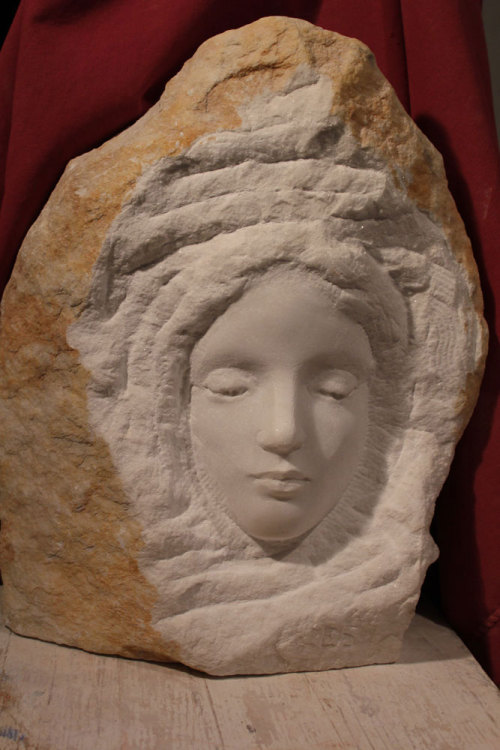
“Angel,” marble, 2012.
Far from being non-finito or unfinished, Sullivan said, these works by Michelangelo were intentionally left as they were. He explained from his own experience carving the “Cararra Madonna and Child” how the marble was soft, so that when he sanded it down, he would lose a significant amount of dimension and contour. With his “Pieta,” he left the base of the marble to retain the sense of the original block and to convey how the figures were found within. Michelangelo carved in a similar way, peeling back the marble and “discovering” his forms in the stone. Sullivan understands his art as continuous with the past and part of a long tradition.
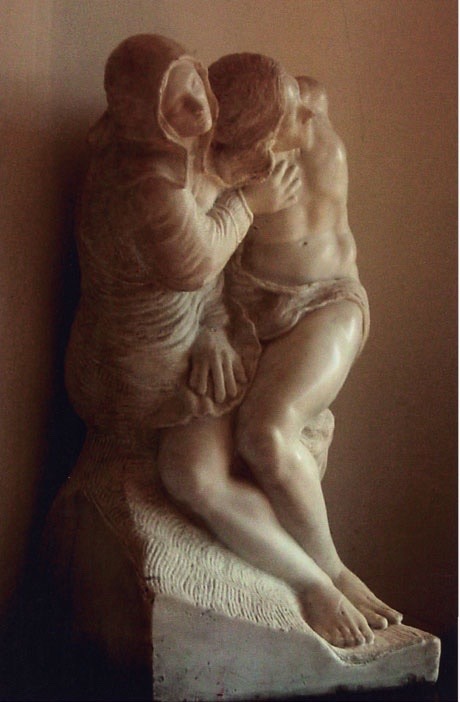
“Pieta,” marble, 22″ high, 1981.
Modernists break from the past when they dispense with representation. The break stems from a Cartesian dualism, Sullivan said, and the meaning of the art becomes entirely subjective.
The exhibit “Sacred Art and the Theology of the Body” is an invitation to move one step closer towards a fuller vision of man in his relation to others and to God. The beauty of the human form in art has the power to move man to a deeper understanding of the divine.
In the oft-quoted, off-the-cuff remarks of Pope Benedict XVI to priests in Brixen, he said:
“For me, art and the saints are the greatest apologia for our faith… All the great works of art…they are all luminous signs of God and therefore truly an appearing, an epiphany of God. And in Christianity it is precisely a matter of this epiphany: that the hidden God became Epiphany—he appears and shines… Christian art is a rational art… but it is the artistic expression of a greatly expanded reason, in which heart and reason encounter each other. This is the point. I believe that in a certain way this is proof of the truth of Christianity: heart and reason encounter one another, beauty and truth converge, and the more that we ourselves succeed in living in the beauty of truth, the more that faith will be able to return to being creative in our time too, and to express itself in a convincing form of art.”
Sarah Blanchard for academics-amu

Risen Christ, Saint Zepherin’s Church, Cochituate, Massachusetts, Imperial Danby Vermont marble, black granite, Rosso Levanto Turkish marble, life size, 1992.
As a Traditional Sculptor I was presented with the problem of making an Architectural setting and a sculpture for the new Saint Zepherin’s Church that had the architecture of a meeting hall. I use a Renaissance Marble Carving Method .See my article- Looking over Michelangelo’s Shoulder as He Carves Marble- http://www.corneliussullivan.com/gloucester_lectures.html
The sculpture is part of a permanent Architectural element designed by the sculptor at Saint Zepherin’s Church
I took the shape of the Palladian arch in the architecture of the building and copied that exactly in shaping and cutting the back marble slab. To symbolized the Veil of the Temple splitting I split in two the perfect piece of very expensive Rosso Levanto Turkish Marble with several well placed blows.
The slightly larger than life size head of white marble was perfect for a Risen Christ. It had monumentality from the beginning in the stone. That is reminiscent of Michelangelo’s Neo-Platonist ideas about beauty inside the block waiting to be discovered. I carved a detailed Head of Moses, it had dignity and a presence. I saw beyond that the vision of the Risen Christ and used tools to erase all surface details of Moses with the result looking for an other worldly beauty and mystery. I have been told that the features are perfect. I think that people are allowed to see what they see because the details are not so specific and therefore not limiting. Who wants to see a Photo Realistic Risen Christ? His body was glorified.
The idea for the finish of the Risen Christ came from a marble Pieta where the Virgin Mary is clear in appearance, detailed, in our world, wheres the Christ has a different look, not so detailed, being in a different place of mystery.
I could not stand the detail and would undo the clarity and go for the mystery again and again. The beautiful marble allowed for that process to continue and indeed always called for more mystery. Doing the same thing for 13 years and expecting different results coincides with Einstein’s idea of insanity. But I did it like an artist, I expected the same results but hoped they would continue to look better. Apropos to carving one sculpture for13 years, Einstein said, “It’s not that I am so smart, it’s just that I stay with projects longer.” Thematically, in this case, it all made sense that the corpus of the Pieta could be on the road to soon be a Risen Christ.

Pieta, Carrara Marble, life size, 2006 – 2018. in process, almost finished.
The Italian sculptor, Medardo Rosso, also in Paris with Rodin and Brancusi in 1906, made his most well known work, Ecce Puer. He put wax over plaster producing a special surface. Apparently he influenced Rodin toward an impressionism (small i) in sculpture.

Ecce Puer, Medado Rosso

Before and After, Moses becoming the Risen Christ
The old Saint Zepherin’s was a typical church from the end of the Nineteenth Century with stain glass windows and painted life size plaster statues of saints. They would not be called sculptures. The church was replaced by something that looked like a meeting hall. My marble carving method is a Renaissance one of carving directly on the stone guided by drawings and maybe a small clay model. The commission was to make a Modern work to fit into the contemporary space. In the idea that I had for the Risen Christ I envisioned transforming the Renaissance like detail into something more simple. I had one foot in a Renaissance school of carving and the other in the twentieth century “Direct Carving” school. That is the church that I ran around in as a child and it formed my taste. Content and meaning were paramount.
It was an honor to do this in the church where I was an altar boy for the Latin Mass. I can close my eyes and see statues and the stained glass windows and Stations of the Cross.
My mother and her friend Grace Courchine were the Saint Zepherin’s Altar Society and on Saturday Mornings they would replace the altar cloths and vacuum the rugs as I ran around the pews and studied the art.

Sculptor and Rise Christ
Saint Zepherinus was Pope from 217 to 222, when he was martyred. He is buried in the Roman Catacomb of Saint Callixtus in a room with Saint Cornelius Pope from 251 to 253. Cornelius only lasted two years. I published an article in the The Italian Insider Newspaper in Rome in which I had an imaginary interview with Saint Peter about Martyrdom. I asked him about his expression being crucified upside down in the Caravaggio painting.
http://www.corneliussullivan.com/my_interview_with_saint_peter4.html
He (St Peter)continued, “So to conclude about martyrdom. Do you know that all but two, of the fifty two of my immediate successors as Bishop of Rome are saints, most were martyrs?”
I was proud to say, “I know, someone gave me a piece of paper on the street in 2005 with a list of all the popes. Typed in at the bottom was the name of the new pope. I have kept that list. It is well worn, I will tell you how I used it. Some years ago I did tours of the Vatican Museums. There was another docent who was saying that the museums were all about propaganda and the Church reifying its power. I was not content to read the interpretations of historians of what the place was about. I hoped that I could know for myself the reality behind the grand collection and the buildings. The key was the paper that I had saved. The place is built over the grave of the fisherman, you, and on the blood of the martyrs. When I showed it to visitors they noticed the capital “M”, for martyr, after the names of the first popes, thirty three of them, often in office for a short time. Pope Cornelius made it for three years before he was murdered. I continued, Caravaggio painted many martyrdoms.”

Writing

Writing Articles published in The Italian Insider Newspaper based in Rome and in The St. Austin Review Magazine, South Bend, Indiana.
Looking over Michelangelo’s Shoulder as He Carves Marble
CARAVAGGIO
Caravaggio Speaks to the Modern Age June 20, 2012
Caravaggio’sRaising of Lazarus
Who is Saint Matthew for Caravaggio
Rome’s extravagant celebration of Caravaggio- How can we know another man’s death.
Caravaggio, Saints and Sinners- Caravaggio painted sinners as saints.
Caravaggio, the most Unlikely Candidate
Caravaggio on the Run in Malta
Interview with Saint Peter, the Art of Martyrdom November 3, 2012
Attacks on Caravaggio I saw him there in the street, the narrow street, Via del Leone, June 4, 2012
Caravaggio Reveals Himself- The most unlikely candidate August 3
Caravaggio and the Marilyn Elvis Syndrome- Only the good die young. July 25
Caravaggio and the Aesthetics of Meaning- Caravaggio is the antidote to Conceptual Art. September 27,
Caravaggio, Rembrandt, and Vermeer, not just realists- Caravaggio used light to tell the story. September 6
Who is Saint Matthew for Caravaggio August 7, 2012, revised June 2, 2018
Another Bogus Caravaggio Discovery July 10, 2012
Tranquillo Caravaggio, the Town June 26, 2012
Caravaggio Borrows from Michelangelo December 18, 2011
MICHELANGELO
Michelangelo in Rome November 15, 2011
Carving Marble by the Michelangelo Quarry in Carrara Summer 2014
A Lost Michelangelo, don’t get your hopes up July 18, 2012
SACRED ART
Sacred Art and the Theology of the Body, Caravaggio, http://www.italianinsider.it/?q=node/2843
Sacred Art and The Theology of the Body, Part One, Caravaggio related-Exhibition at Ave Maria University, 2015,
ART CRITICISM
The first article published by The Italian Insider Newspaper-
Capeman II: Papal Statue not Improved November, 20, 2012 “Well said”.- M.P., “Great Article”-C.S., P.A.
Rev. Martin Luther King Jr. as Mao February 2012
Art Mysteries Solved, a Leonardo, a Michelangelo, and a Raphael October 11
Moor Fountain in Piazza Navona vandalized
Does God Have a Face? http://www.italianinsider.it/?q=node/3201
Sacred Art and The Theology of the Body
OTHER
American Views of the Amanda Knox Verdict November 3
The Roman Forum June 8, 2012
March 23, 2016 I wrote this short piece yesterday for John and Ashley in Rome who produce Voice of the Vatican, for a TV video they are shooting today.
https://youtu.be/gKi9zSyXmfc?t=29m15s
Marble Carving.
INTRODUCTION TO CARVING MARBLE, video by Brendan Weston https://www.youtube.com/watch?v

all content copyright Cornelius Edmund Sullivan 2024

